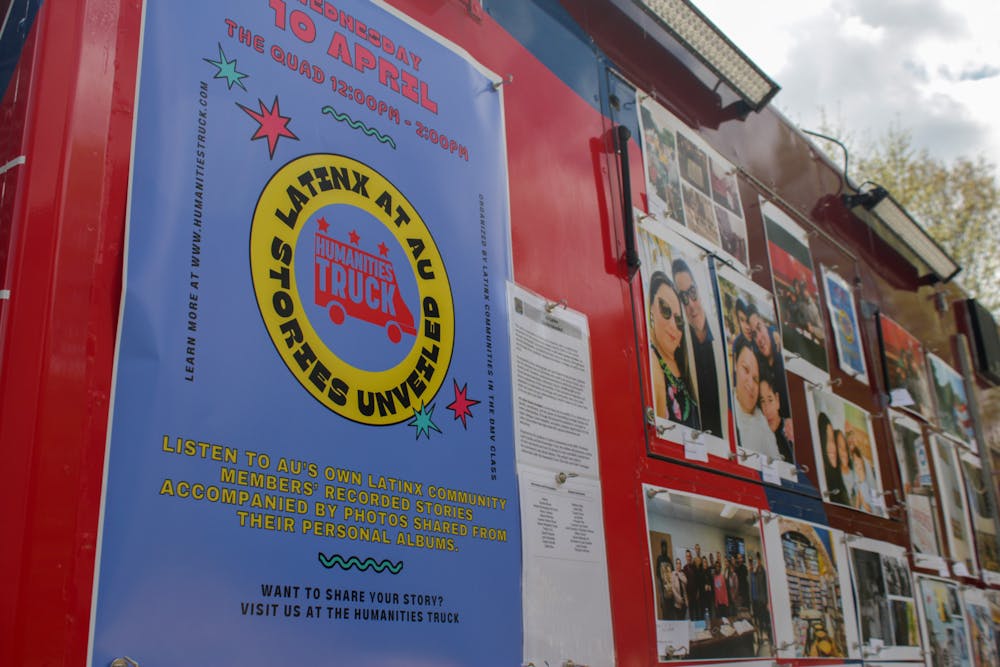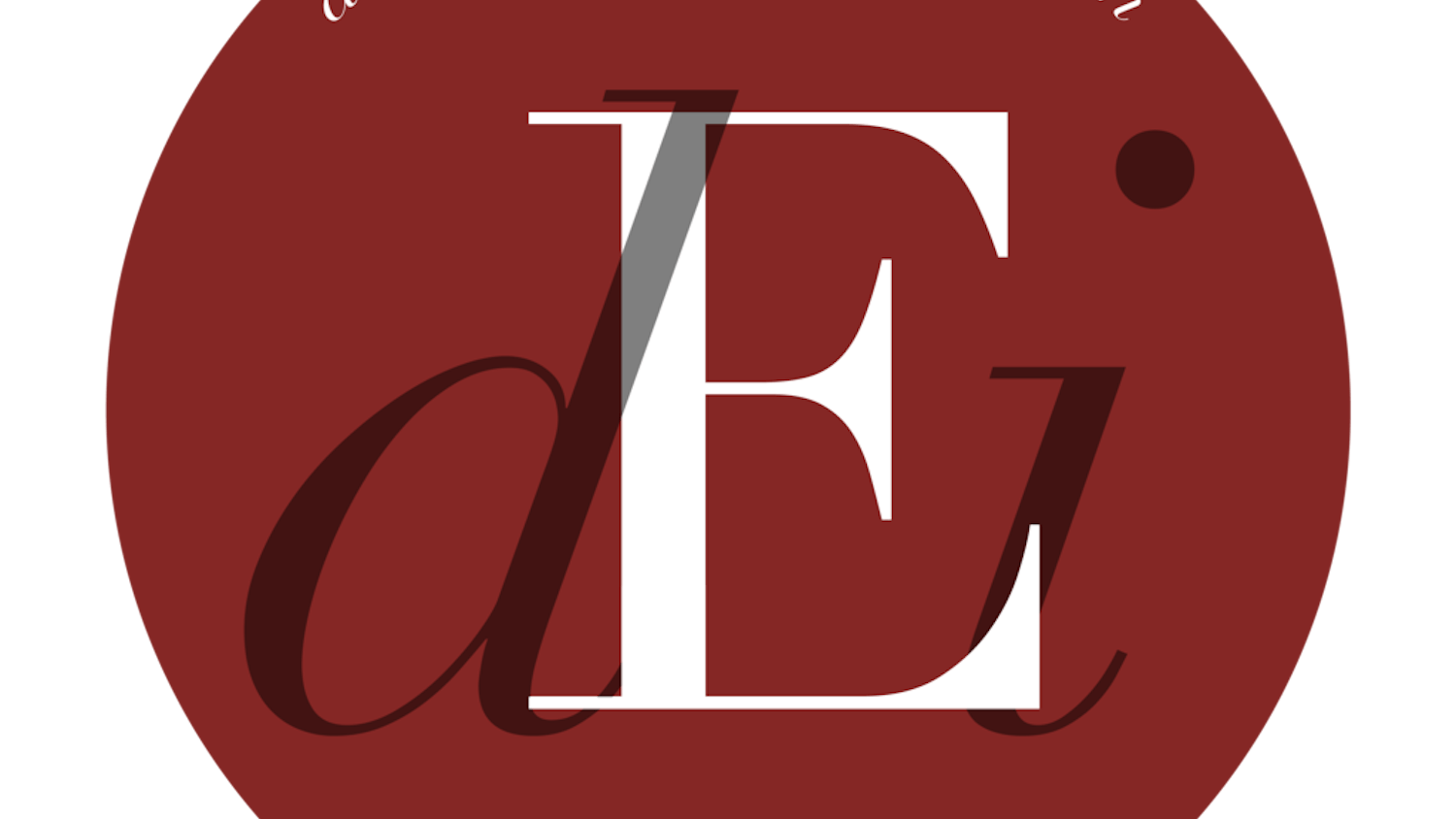Professor Ludy Grandas’ “Latinx Communities in the DMV” class organized a “Latinx at AU: Stories Unveiled” exhibit with AU’s Humanities Truck on the quad on April 10 to showcase recorded interviews and personal photos from American University’s Latino community.
At the exhibit, the students chatted and asked Grandas to take photos with them. Multiple students also participated in a project next to the truck, where they wrote cards in Spanish to AU facilities workers.
“It has been incredible,” said Priyanka Nair, a junior in the School of International Service and one of Grandas’ students. “Getting to know the members of the community much better, especially the Latino community here at AU.”
Preparing for the event
The Humanities Truck is an AU initiative to bridge the gap between the University and the wider D.C. community by participating in events around the District, such as a Lunar New Year celebration and the Adams Morgan Day Festival.
Grandas, a senior professional lecturer in the Department of World Languages and Cultures and a Humanities Truck Project Fellow, has used the truck at different events, including an event last month in Columbia Heights to raise awareness on D.C. residents’ right to vote regardless of their migratory status.
Because of her past experiences with the Humanities Truck, Grandas said she knew it would be useful to this class project.
“The voices of the Latino community are not very well-represented outside the community,” Grandas said. “I decided to use the Humanities Truck resources to highlight the lives and to listen to the life stories … of the Latinx community at AU.”
“Latinx Communities in the DMV,” a three-credit Community-Service Learning Project class taught in English, is cross-listed in the Department of Critical Race, Gender and Culture Studies under American Studies and Latina/o/x Studies. It requires students to complete 20 hours of volunteer or internship work with a community partner.
In addition to their broader community work, Grandas wanted her students to engage in multiple on-campus class projects throughout the semester, saying she envisioned “direct engagement with people from the Latino community at AU.”
Though this exhibit was Grandas’ idea, her students coordinated most of the interviews. One issue that arose was that multiple students had never had experience holding or editing interviews, according to Grandas. Students prepared by holding 10-minute mock interviews in class, which they had to edit down to two-minute clips.
The final exhibition included audio recordings from interviews with AU professors, staff members and one student, as well as their personal photos. The photos were displayed on the truck, with captions written by Grandas’ students.
Nair said her favorite aspect of the project was the photos.
“It was really nice to either put a face to the people, their heritage or their background. So having those pictures really helped me understand more about the community,” Nair said.
Card-writing collaboration
The exhibit also became an unexpected collaboration beyond Grandas’ class and their interviewees. Shelby Liebler, a sophomore in the School of Public Affairs, was connected with the exhibit through her own project.
As a part of the SPA Leadership Program, second-year students like Liebler participate in a personal project guided by their own interests. This semester, Liebler decided that she wanted to make thank-you cards for Spanish-speaking employees at AU.
“I’m an RA, and I see in the buildings on campus a ton, as we all do, the impact that the custodians and facilities employees have on this campus is massive,” Liebler said.
She noted that some aren’t fluent in English, which makes it difficult for most of the student body and staff to show their appreciation day-to-day.
Liebler made flyers for her project and reached out to one of her Spanish professors, who notified other faculty of Spanish and Latin American Studies. Those professors then connected her to Grandas’ class project.
The card-making was set up at a table next to the Humanities Truck, where visitors could decorate and write cards in Spanish. After the exhibit, Liebler had over 80 cards.
“I went out there and sat with her and her wonderful class,” Liebler said. “Their exhibit was so cool, and I think that the way they were showcasing different experiences was very, very powerful.”
Grandas and her class appreciated Liebler’s involvement.
“I thought it was a really nice gesture,” Nair said. “A lot of people came up to us … for both the Humanities Truck and the card-writing, which was really, really nice.”
Grandas said she enjoyed talking with passersby who approached the exhibit and met three students who she said are “on my radar for other projects.”
For Nair, speaking with her interviewees at the final exhibit was also impactful. A professor she interviewed had originally “expressed that she didn’t really feel like she belonged here in the Latino community in D.C.,” Nair said.
“But, after the exhibit, when we were talking, she was telling me how this exhibit really gave her a sense of community, like brought her happiness, and that meant a lot to me,” Nair said. “Even if it was just a 13-minute interview.”
Correction: A previous version of this article misstated the number of credits this class is worth and did not clarify that the class included other projects. The article has been updated to reflect these facts.
This article was edited by Kathryn Squyres, Zoe Bell, Tyler Davis and Abigail Turner. Copy editing done by Luna Jinks, Isabelle Kravis and Ariana Kavoossi.





